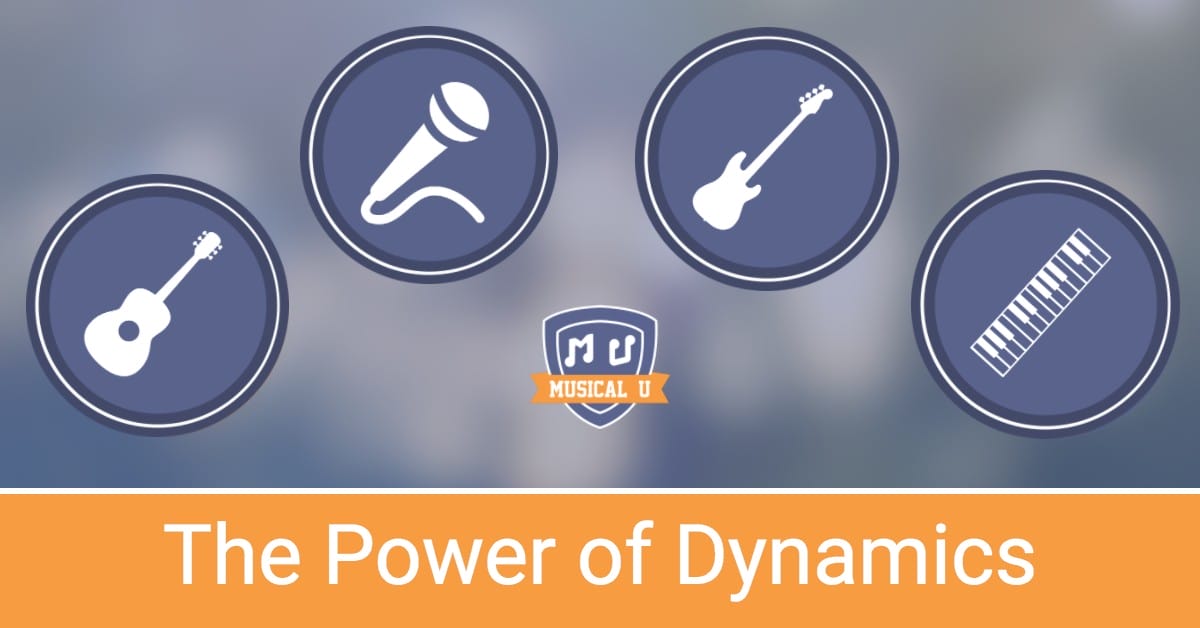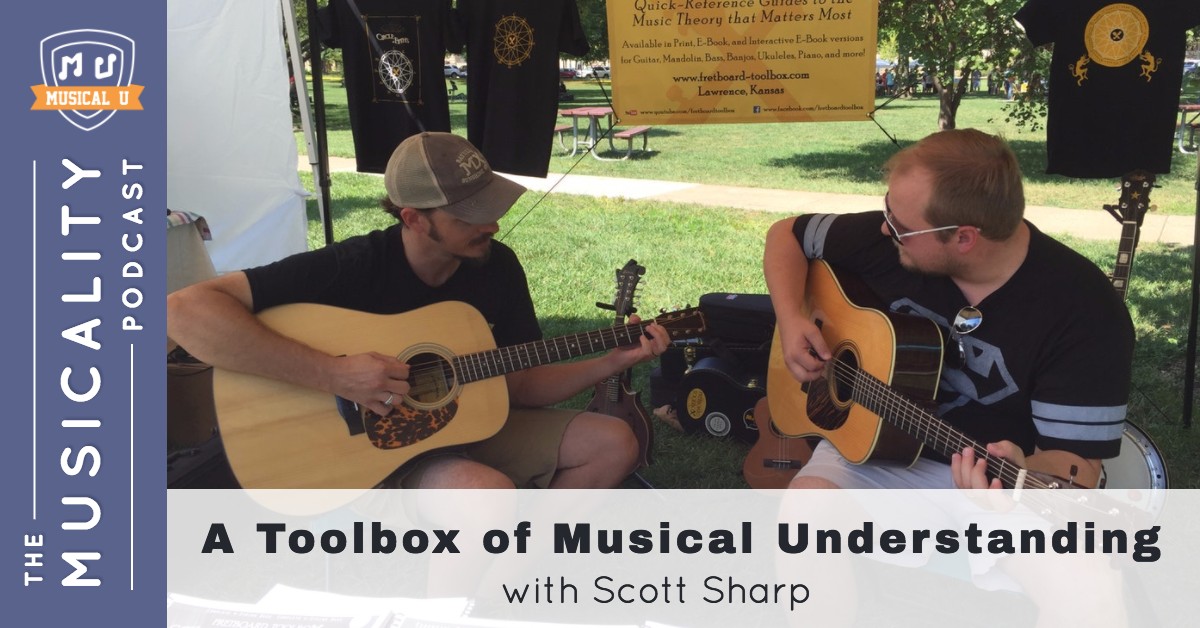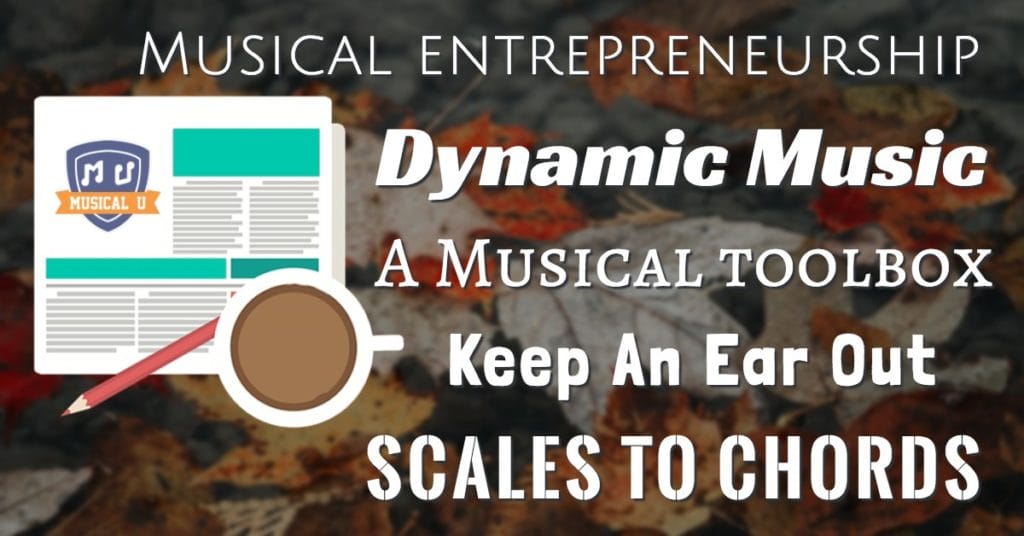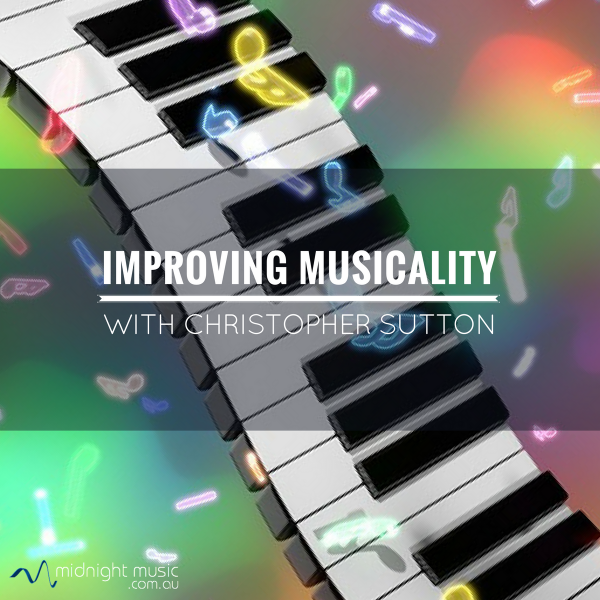Regardless of whether you play the guitar, piano, violin, or hurdy-gurdy, there are some skills that are helpful to all musicians, and can be translated from instrument to instrument.
This week was about developing four of those core skills: including dynamics in your playing, learning the basics of playing, working on active listening, and making the connection between scales and chords. If you’re looking to deepen your understanding of how music works and play naturally and expressively, this is a fantastic place to start!
But before we dive into all that…
This week, Christopher Sutton gives two interviews about why he started Musical U, the highs and lows of the entrepreneurial journey, and the tools he uses to keep the company running.
Musical Entrepreneurship
 This week, Musical U founder Christopher Sutton heads over to Music Entrepreneur HQ and Midnight Music for guest podcast episodes on musicality and entrepreneurship.
This week, Musical U founder Christopher Sutton heads over to Music Entrepreneur HQ and Midnight Music for guest podcast episodes on musicality and entrepreneurship.
On Music Entrepreneur HQ, he discusses his own music journey, why he started Musical U, the tools he uses to run his business, the entrepreneurial decision-making process, and the ups and downs of running your own company (and advice on getting through the lows!).
Head over to The Music Entrepreneur HQ to listen to How to Become a More Confident Musician & Living the Entrepreneurial Life – with Christopher Sutton of Musical U!
 The Path of Musicality
The Path of Musicality
Meanwhile, over at the Music Tech Teacher Podcast, Christopher is interviewed by Katie Wardrobe, music technology education trainer, speaker, and consultant from Midnight Music. On Improving Musicality with Christopher Sutton, he discusses musicality, ear training as a means to an end, and how to tie your training to what matters to you, whether that is improvising, playing by ear, or learning the Für Elise.
Christopher and Katie also talk about how technology can help in your ear training progress, with the availability of ear training apps and games that help contextualize and liven up the learning process.
Last but not least, Christopher shares some lessons and anecdotes from his entrepreneurial journey – from his transition from a day job to running his own company, to his early aspirations of starting a porridge blog!
Dynamic Music
Out of the countless ways you can add interest, variation, and expressiveness to your playing, dynamics are one of the most powerful and immediate – you can build and release tension, change the mood of a piece, and effectively tell a story with your music.
 In this month’s Instrument Packs, our guitar, bass, and piano pros show you how to train your ear to better recognize dynamics and apply them in your playing, provide practice tracks to give you a place to start, and teach you instrument-specific techniques for controlling dynamics.
In this month’s Instrument Packs, our guitar, bass, and piano pros show you how to train your ear to better recognize dynamics and apply them in your playing, provide practice tracks to give you a place to start, and teach you instrument-specific techniques for controlling dynamics.
Head over to The Power of Dynamics: Resource Pack Preview to read more about how Dylan Welsh, Sara Campbell, and Steve Lawson can help you express yourself musically through dynamics, and to learn more about Musical U’s offerings for instrument-specific training!
As we are all too aware, most musical notation relies upon Italian musical terms to convey how loud or fast a song is to be played. Skype Guitar Lessons Online has a quick cheat sheet of the dynamics you can expect to see in your musical reading.
Dynamics play such an important role in music, and not just from the individual musician’s perspective. An entire band’s dynamic presence and contrast can greatly enhance the listener’s experience. Production Advice recently discussed this topic in relation to the new Foo Fighters album, and how lowering the volume created a more powerful recording.
The Musical U Resident Pros talked about how dynamics are not just about a volume knob, but in how the instrument itself is played. In no instrument is this more true of than the drums. Online Drummer shows how dynamic contrast can be achieved by playing the drum set in a particular way, and how doing so greatly enhances the drum parts.
A Musical Toolbox
Countless mental roadblocks may stop people from picking up music: they think they are “unmusical”, too old to learn a new instrument, or that they’ll never understand music theory.
The truth is, anyone who enjoys music can successfully teach themselves to play an instrument, improvise, and write music. Sometimes, all it takes is a little help.
Scott Sharp understands these mental roadblocks from his own first-hand experience, and has created a wonderful resource called Fretboard Toolbox to help musicians understand notes, chords, scales, and the ways in which the three go together. This, as he explains in A Toolbox of Musical Understanding, with Scott Sharp, is the foundation for playing by ear, improvising, and writing memorable melodies and chord progressions. Best of all, the Fretboard Toolbox functions as a musical shortcut, and will have you playing in no time, without needing to understand complicated music theory.
Starting with the basics when learning to play music will help build a solid foundation for later skills (and build your confidence!). Scales are an excellent place to start to get your fingers moving and acquainted with your instrument. Many of us begin with the major keys when first learning scales. Fretboard Toolbox has developed major scale worksheets to give you a leg up!
Scott talked about how he accidentally learned music theory from one of his students. While theory may be intimidating to learn, it is largely based upon practical application of musical techniques from generations of musicians. Check out Online Piano Coach’s set of resources to get a solid start on your theory journey.
After understanding how chord progressions work within their corresponding scales, you are well on your way to creating your own masterpieces. Many musicians have developed their own systems to understand what chords work well together. This is a great way to help develop your own sound and basis of music theory. Born Hero talks about how he has created chord maps that speed up his music creation process and help ensure his creations always sound great.
Scott talked about how useful jam tracks were to his growth as a musician. In our digital era, jam tracks are very easy to find, and can be a great tool for your musical growth. To get some blues music under your fingers with a jam track from Next Level Guitar.
Keep An Ear Out
When was the last time you really listened to a piece of music?
 Not as background noise while you were commuting to work, cleaning the house, or doing your taxes. But putting your headphones on, tuning the world out, and listening to a song completely undisturbed.
Not as background noise while you were commuting to work, cleaning the house, or doing your taxes. But putting your headphones on, tuning the world out, and listening to a song completely undisturbed.
This sort of deliberate listening is called active listening, and it greatly pays off for anyone wanting to deepen their understanding and appreciation of music.
In Getting Your Ear In Gear, pianist and music educator Ruth Power shares the secret of listening in layers, and the power of repetition in active listening. Showing you what to keep your ear out for with each consecutive listen, she provides thought-provoking questions that you can ask yourself as you listen.
A recent article indicated that streaming services have resulted in more music being listened to than ever before. But most of the times we are listening to music for recreation, in a very passive way. Learning to actively listen to music can be difficult for many, but there are specific qualities that you can pay attention to that will enhance your understanding of a piece of music. For more tips, check out Adam Estes Winds’ listening points!
Ruth discussed that is important to practice mindfulness when consuming music, and deliberately working to be “present in the moment”. This can not only be applied to listening to music, but also playing music, as JB Music and Mindfulness discuss.
With all this talk about learning to hone your musical ear, have you ever thought of deconstructing your own musical consumption? This will help you gauge just how much active music listening you do per day, and figure out how you can increase your intake of learning through listening. Looking for a way to begin? Follow the example of Dan from the Composer’s Toolbox, as he examines and analyzes his own music listening habits!
Scales to Chords
Scales are often the first thing we learn on our instrument – a sequence of notes that sound good played together and that can be used as a basis for improvisation.
 Out of these scales, we can put together combinations of notes that also sound good when played together and can be put to good use in improvisation: chords!
Out of these scales, we can put together combinations of notes that also sound good when played together and can be put to good use in improvisation: chords!
The connection between scales and chords is tighter than you think, and every scale has certain chords that can be built on each scale degree. Understanding this relationship will help you create chords on the fly, write memorable songs, and combine chords and scales in your improvisation.
In the Musicality Podcast episode About Finding Chords in Scales, we share one simple trick you can use to build a chord on any note in a scale, to get you started!
As discussed in this podcast, chords have specific qualities depending on the scale that they are based on. For most musicians, the major scale is the first that you must master to be proficient in scales. Oliver at Oolimo has created an interactive tool that will spell out the chords that can be found in the major scale.
The next step to chord and scale mastery is to be able to use your chord progressions as a foundation for creating a solo. This was touched upon in our podcast on chord tones, but is expanded to include the full pentatonic scale in this fantastic lesson from Eric Haugen.
When learning to play chords within scales, you may find yourself referring more to what scale degree the chord is based upon instead of a chord name. This is often called the numbering system, and is discussed in detail by Instant Piano Lessons.
Basics to Masterpieces
Including a range of volumes in your playing, getting a solid grasp of musical building blocks such as scales and chords, and learning to actively listen to music (including your own!) are basic things that can make the difference between uninspired, by-the-book playing, and a relaxed, natural, confident, and moving performance.
Take the time to learn the basics, and watch it work wonders for your improvisation, playing by ear, and songwriting!








